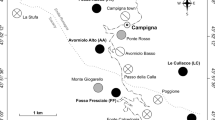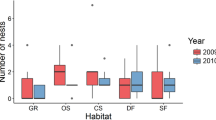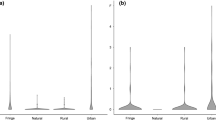Abstract
The crazy ant (Anoplolepis gracilipes) invaded Bird island, Seychelles, in the 1980s. In 1997, its range expanded and population densities increased. The impacts of this change were studied in 2001 using a combination of arthropod collecting methods. The ant population excluded larger invertebrates (principally the large ant Odontomachus simillimus and the crabs, principally Ocypode spp.). Cockroaches, however, remained abundant in ant-infested areas and tree-nesting birds (Lesser Noddy Anous tenuirostris) appear to be able to breed successfully in the presence of the crazy ant. The ants are only abundant in areas of deep shade which provide cool nesting areas, yet enabling them to forage in the open when ground temperatures fall. The expansion of the ants was correlated with the regeneration of woodland on the island. Recommendations are made for the management of the woodland which may reduce the impacts of the crazy ant.
Similar content being viewed by others
References
Benoit P.L.G. 1978. Contributions à l'étude de la faune de terrestre des îles granitiques de l'archipel des Séychelles (Mission P.L.G. Benoit-J.-J. Van Mol 1972). Introduction. Rev. Zool. Afr. 92: 390-404.
Bond W. and Slingsby P. 1984. Collapse of an ant-plant mutualism: the Argentine ant (Iridomyrmex humilis) and myrmecochorous Protaceae. Ecology 65: 1031-1037.
Brandão C.R.F. and Pavia R.V.S. 1994. The Galapagos ant fauna and the attributes of colonizing ant species. In: Williams D.F. (ed.), Exotic Ants: Biology, Impact and Control of Introduced Species, Westview Press, Boulder, CO.
Clark D.B., Guyasamín C., Pazimiño O., Donoso C. and Pàex de Villacís Y. 1982. The tramp ant Wasmannia auropunctata: autecology and effects on ant diversity and distribution on Santa Cruz Island, Galapagos. Biotropica 14: 196-207.
Dammerman K.W. 1929. The Agricultural Zoology of the Malay Archipelago. J.H. De Bussy Ltd., Amsterdam, 473 pp.
De Kock A.E. and Giliomee J.H. 1989. A survey of the Argentine ant, Iridomyrmex humilis (Mayr) (Hymenoptera: Formicidae) in South African fynbos. J. Ent. Soc. S. Afr. 52: 157-164.
Dorow W.H.O. 1996. Review and bibliography of the ants of the Seychelles (Hymenoptera: Formicidae). J. Afr. Zool. 110: 73-96.
Feare C.J. 1979. Ecology of Bird Island, Seychelles. Atoll Res. Bull. 226: 1-26.
Feare C.J. 1999. Ants take over from rats on Bird Island, Seychelles. Bird Consev. Int. 9: 95-96.
Feare C.J. and Gill E. 1997. Life cycle of the tick Amblyomma loculosum in a sooty tern Stena fuscata colony in the Seychelles. J. Zool. 241: 643-68.
Fryer J.C.F. 1909. Bird and Dennis Islands, Seychelles. Trans. Linn. Soc. Lond. (Zool.) 14: 15-18.
Gerlach J. 2003. Biodiversity of the granitic Seychelles islands. Phelsuma 11A: 1-48.
Greenslade P.J.M. 1971. Interspecific competition and frequency changes among ants in Solomon Islands coconut plantations. J. Appl. Ecol. 82: 323-353.
Haines I.H. and Haines J.B. 1978a. Colony structure, seasonality and food requirements of the crazy Anoplolepis longipes (Jerdon), in the Seychelles. Ecol. Entomol. 3: 109-118.
Haines I.H. and Haines J.B. 1978b. Pest status of the crazy ant, Anoplolepis longipes (Jerdon) (Hymenoptera: Formicidae), in the Seychelles. Bull. Entomol. Res. 68: 627-638.
Haskins C.P. and Haskins E.F. 1965. Pheidole megacephala and Iridomyrmex humilis in Bermuda-equilibrium or slow replacement? Ecology 46: 736-740.
Hilton-Taylor C. (Compiler) 2000. 2000 IUCN Red List of Threatened Species. IUCN, Gland, Switzerland and Cambridge, UK.
Hill M.J. 2002. Assessing conservation value of islands in the central Seychelles. Atoll Res. Bull. 495: 1-254.
Holway D.A. 1995. Distribution of theArgentine ant (Linepithema humile) in northern California. Cons. Biol. 9: 1634-1637.
Human K. and Gordon D. 1996. Exploitative and interference competition between the Argentine ant and native ant species. Oecologia 105: 405-412.
Lewis T., Cherrett J.M., Haines I., Haines J.B. and Mathias P.L. 1976. The crazy ant (Anoplolepis longipes) (Jerd.) (Hymenoptera, Formicidae) in Seychelles, and its chemical control. Bull. Entomol. Res. 66: 97-111.
Lowe S., Browne M. and Boudjelas S. 2001. 100 of the world's worst alien species. Aliens 12: 1-14.
McGlynn T.P. 1999. The worldwide transfer of ants: geographic distribution and ecological invasions. J. Biogeogr. 26: 535-548.
Moller H. 1996. Lessons for invasion theory from social insects. Biol. Conserv. 78: 125-142.
O'Dowd D.J., Green P.T. and Lake P.S.A. 1999. Status, impact and recommendation for research and management of exotic invasive ants in Christmas Island National Park. Report to Environment Australia.
Porter S.D. and Savignano D.A. 1990. Invasion of polygyne fire ants decimates native ants and disrupts arthropod community. Ecology 71: 2095-2106.
Robert S. 1998a. News from Bird. Birdwatch 26: 8-9.
Robert S. 1998b. News from Bird. Birdwatch 27: 9-11.
Robert S. 1998c. News from Bird. Birdwatch 28: 11-12.
Robert S. 1999a. News from Bird. Birdwatch 31: 19-21.
Robert S. 1999b. News from Bird. Birdwatch 32: 13-15.
Stoddart D.R. and Fosberg F.R. 1981. Bird and Denis Islands, Seychelles. Atoll Res. Bull. 252: 1-50.
Tsutsui N.D. and Suarez A.V. 2003. The colony structure and population biology of invasive ants. Conserv. Biol. 17: 48-58.
Vinson S.B. 1991. Effect of the red imported fire ant (Hymenoptera: Formicidae) on a small plant-decomposing arthropod community. Environ. Entomol. 20: 98-103.
Williams D.F. 1994. Exotic Ants: Biology, Impact, and Control of Introduced Species. Westview Press, Boulder, CO.
Wilson E.O. and Taylor R.W. 1967. An estimate of the potential evolutionary increase in species density in the Polynesian ant fauna. Evolution 21: 1-10.
Author information
Authors and Affiliations
Rights and permissions
About this article
Cite this article
Gerlach, J. Impact of the invasive crazy ant Anoplolepis gracilipes on Bird Island, Seychelles. Journal of Insect Conservation 8, 15–25 (2004). https://doi.org/10.1023/B:JICO.0000027454.78591.97
Issue Date:
DOI: https://doi.org/10.1023/B:JICO.0000027454.78591.97




